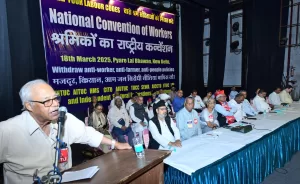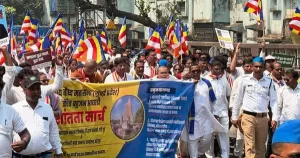“Ramma cul sasn” – the king who has entered the religion [of Islam].
This was how the mid-17th century Buddhist-Hindu kingdom of Cambodia referred to its monarch, Reameathipadei, when he converted to Islam and took the title Sultan Ibrahim.
Although disapproving, the court respected the king’s decision – even after his death. “It is remarkable that Reameathipadei was given a Buddhist funeral and that his Muslim regalia were retained by a Buddhist-Brahmanic court,” writes Dutch scholar of Islam, Carool Kersten, in his study of contemporary indigenous and European accounts of the event.
History also records that the 15th century ruler of the then new Muslim state of Malacca, Sultan Muhammad Shah, became Shri Maharaja Muhammad after taking the prestigious title of his Buddhist-Hindu predecessors.
A pluralist ethos marks southeast Asia’s past and present, reflecting a civilisational maturity that shames those who speak of ancient India’s spiritual ‘legacy’ overseas in making the self-laudatory vishwa guru claim while stoking an ugly communal divide at home.
Even a snapshot of the independent historical scholarship on India’s past in the region reveals how religious and cultural influences originating in India melded into a distinct southeast Asian form characterised by a pluralist weave.
Perhaps it is time for India to reacquaint itself with how its overseas influence was thus enriched in southeast Asia, maturing into a civilised pluralism. Indian diplomats and visiting dignitaries in southeast Asia, wont to delivering smug reminders to their hosts of the region’s ‘deep civilisational links’ with India, need to take home the message learned from the region’s pluralist ambience.
Pluralism in the civilisational connect
Instead of a dysfunctional focus on religious differences degenerating into social squabbling and worse, southeast Asia saw pluralism striking deep historical roots. As the late Indonesian cultural historian Haryati Soebadio said of the apparent Shaivite-Buddhist syncretism in pre-Islamic Java, this reflected an understanding that all faiths seek the “same ultimate goal using different ways.”
An appreciation of the oneness of all faiths can also be seen in the statement of a king in pre-Islamic Java, cited by noted southeast Asian cultural history scholars J.G. de Casparis and I.W. Mabbett, that “there is no difference between Buddhism and Islam: they are two in form, but only one in essence.”
Unlike in the land of its birth where Buddhism all but disappeared, southeast Asia saw its synergy with Hinduism, strikingly evident in the ‘Shiva-Buddha’ title of 13th century Javanese monarch Kertanagara and manifested enduringly in grandiose monuments – the Candi Singosari (a royal mausoleum commemorating Kertanagara), the Buddhist Borobudur and the Shaivite Prambanan temple complex, all in Java, as well as the Vishnu-centric Angkor Wat and the Buddhist Bayon in Cambodia.
Moreover, Brahmin priests who perform the Vedic royal consecration in Thailand to this day, as elaborately described in a rare first-person European account by early 20th century British official in the Thai royal court, H.G. Quaritch Wales, are also ordained as Buddhist monks.
From Buddhist-Brahman to Muslim-Brahman
The arrival of Islam in the 13th century CE did not disrupt the region’s 1000-year-old Buddhist-Hindu zeitgeist which was embraced by the new Muslim rulers as mentioned earlier, with the Malacca sultan’s change of title from ‘Sultan’ to ‘Shri Maharaj’.
The 17th century Malacca court annals, Sejarah Melayu, “purposely connected” the royal Muslim lineage to earlier Buddhist-Hindu kings, while southeast Asia’s first Muslim state, Samudra-Pasai in north Sumatra (late 13th century CE), “patterned” its sultan’s “saintlike persona…on the earlier ideal of the Buddhist bodhisattva,” writes K.R. Hall in A History of Early Southeast Asia.
Likewise, “[in Indonesia], with its glorious pre-Muslim tradition, Islam had to compromise with long-established attitudes,” write de Casparis and Mabbett. The most remarkable religious compromise is the hybrid Hindu-Muslim faith of the southern Vietnamese Cham who identify as “Muslim-Brahman.”
Designated “the lost children of Indian culture” by renowned French scholar of Cham history, Paul Mus, this ethnic group has a pedigreed past in the ancient Buddhist-Hindu polity of Champa, which is said to have left behind southeast Asia’s oldest Sanskrit inscription.
A modern constitutional principle
Continuing this historical religious-cultural concord, a pragmatic pluralism underpins modern Indonesia’s secular foundational principle – the Pancasila, a term from its Buddhist-Hindu-Sanskritic past and the basis of its national motto, ‘Bhinneka Tunggal Ika’ (unity in diversity), which former US President Barack Obama likened to the original US motto, ‘E pluribus unum’ (out of many, one). As historian Milton Osborne’s writes, “(there is) a general acceptance that a secular (non-religious) nation is what is required in Indonesia.”
Indeed, after an Islamic candidate’s victory in the May 2017 Jakarta Governor election, the leader of Indonesia’s largest Islamic organisation, the Nahdlatul Ulama, called for strengthening Pancasila-based secularism.
In 2016, prominent Islamic scholar Syafii Maarif, a critic of calls for sharia implementation in Indonesia, defended then Jakarta Governor Ahok, a Christian, against blasphemy charges from hardline Islamic groups.
Attending Syafii’s funeral in May 2022, President Joko “Jokowi” Widodo recalled how Syafii “always respected diversity and voiced religious tolerance.”
In April 2022, lawmaker Lukuk Nur Hamidah demanded protection for religious minorities from the blasphemy law’s abuse “because Indonesia is a pluralistic country.”
Southeast Asia’s past and the Hindu nationalist narrative
Early 20th century Indian historians, understandably, used the ‘discovery’ by awe-struck 19th century Dutch and French colonial-era scholars of India’s scintillating religious and cultural imprint in southeast Asia, to buttress the then anti-British colonial nationalist narrative.
Swayed by this eulogistic history, typified by the works of late 19th century French historian and Indologist Sylvain Levi (L’lnde civilisatrice, or Civilising India) and legendary French scholar of southeast Asia’s Buddhist-Hindu past G. Coedes (Les Etats hindouises d’Indochine et d’Indonesie, or The Indianised States of Southeast Asia), Indian historians took to “flights of fantasy,” depicting countries in historical southeast Asia as “ancient Indian colonies,” wrote southeast Asian history doyen D.G.E. Hall.
This scholarship, he added, “also created much misunderstanding; and the unhistorical myths to which it has given wide currency have shown an amazing power of persistence.”
It also took on an ominous subtext as seen in historian R.C. Mazumdar marvelling in his 1920s-published Ancient Indian colonies in the Far East, at how “for nearly three centuries after India was conquered by the Muhammadans, the banner of Hindu independence was hoisted up in those far-off lands.”
This narrative of an Islamic conquest has been questioned by independent historians.
As K.R. Hall says of the fall of southeast Asia’s last great Hindu kingdom Majapahit: “The Muslims who overthrew Majapahit were local people, not foreigners, and few of their grievances against the old realm were religious in nature.”
Today’s Muslim-majority Indonesia too gives the lie to this myth. The country’s version of the Ramayana is world famous, but not so well-known is the Indian literary epic’s role in Indonesian Islam. The Javanese shadow theatre wayang, enacting themes from the Mahabharata and Ramayana, is a highlight of Muslim religious ceremonies in Indonesia today. A popular wayang performance draws from the 11th century, Mahabharata-based, Indonesian literary classic Arjunavivaha.
Modern Indonesian Islamic schools, pondoks, are patterned on the Hindu guru–shishya ashrams that flourished in ancient Java and the slametan, the Indonesian Muslim feast of peace, is strongly redolent of the Buddhist-Hindu past, “reminding one of similar ceremonial meals in the ancient period.”
At a time when unidimensional historical tropes are roiling India’s national discourse, the words of Cambodian Buddhist-turned-Muslim, Nazy Saleh, president of the Cambodian Muslim Media Center (CAMM), that his country’s “remarkable religious pluralism” can be “a model for other countries,” are a much-needed antidote.
A wisdom ironically missing in the land of the ‘vishwa guru’ in our times.
(Mahesh Uniyal has been a media consultant with the UN regional Asia-Pacific system, based in Bangkok for the past two decades. He is an avid student/researcher of southeast Asia’s past. Courtesy: The Wire.)




